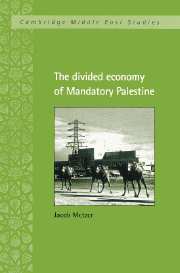Book contents
- Frontmatter
- Contents
- List of figures
- List of tables
- Preface
- Acknowledgments
- Note on numbers
- 1 Palestine's economic structure and performance: introduction and overview
- 2 The peoples of Palestine: a comparative account
- 3 Patterns and characteristics of Palestine's (Jewish) immigration
- 4 Production resources in a divided economy: land, capital, and labor
- 5 Production and trade
- 6 Public sectors in Palestine's economic life
- 7 Postscript: some observations on economic coexistence in ethno-national adversity
- Appendix
- References
- Index
- Cambridge Middle East Studies
4 - Production resources in a divided economy: land, capital, and labor
Published online by Cambridge University Press: 18 December 2009
- Frontmatter
- Contents
- List of figures
- List of tables
- Preface
- Acknowledgments
- Note on numbers
- 1 Palestine's economic structure and performance: introduction and overview
- 2 The peoples of Palestine: a comparative account
- 3 Patterns and characteristics of Palestine's (Jewish) immigration
- 4 Production resources in a divided economy: land, capital, and labor
- 5 Production and trade
- 6 Public sectors in Palestine's economic life
- 7 Postscript: some observations on economic coexistence in ethno-national adversity
- Appendix
- References
- Index
- Cambridge Middle East Studies
Summary
The demographic and socio-economic features, discussed at length in the previous chapters, provide a clear developmental distinction between Arabs and Jews. But the prime cause of the emergence of Mandatory Palestine as a divided economy must be sought in the markets for primary factors of production – land, reproducible capital, and labor. The exchange, ownership, and allocation of land, capital, and labor services have therefore played a major role in the extensive literature dealing with the history of the Arab and Jewish communities in Palestine and with the dynamics and policy implications of their ethno-national conflict.
Historians and social scientists have long dwelt upon both general and “Palestine-specific” features underlying the segmentation of the factor markets and their inner structure, making extremely important contributions to our knowledge and appreciation of the subject. As might be expected, research in the field has not converged to a consensus description, let alone interpretation, of the complex issues involved. This chapter will neither systematically survey the literature nor offer an alternative comprehensive treatment of the subject. Rather, it will concentrate, while reflecting on relevant scholarly contributions, on the economic features that were instrumental in shaping the structure and modus operandi of the factor markets in Mandatory Palestine and in determining their allocative and distributional implications. In so doing, several unresolved questions will obviously be raised, and some tentative answers provided. Naturally enough, the discussion is divided into three sections: the first deals with land, the second with reproducible capital, and the third with labor.
Land
In considering the economics of land in the Mandate period, two interrelated issues stand out.
- Type
- Chapter
- Information
- The Divided Economy of Mandatory Palestine , pp. 84 - 137Publisher: Cambridge University PressPrint publication year: 1998



